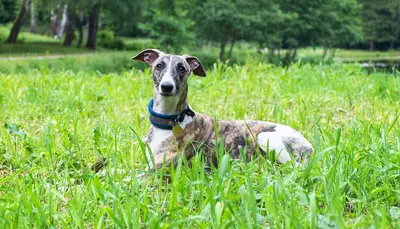Pug: Breed Guide
- 21 Dec 2019
- 6m read

With their iconic wrinkled faces and bouncy personalities, it's easy to see why Pugs are so well-loved by humans. They might be the fourth most popular breed in the UK, according to The Kennel Club, but they're always first in the queue when it comes to playtime.
The best food for pugs will depend on their age, weight, and activity level.They might be small, but Pugs really can eat. There are few things they love more than chowing down and are known for turning on the twinkly-eyed charm around the dinner table on the off-chance a tasty morsel. This makes them liable to porkiness. The PDSA recognises that obesity is a big problem for Britain's dogs, and it can impact your pet's quality of life as well as leading to other illnesses.
Though Pugs can rarely be accused of being fussy eaters, lots of them suffer from food allergies and intolerances, which means it's really impawtant to choose the right dog food to keep them looking and feeling pugtastic.
Based on our current customers, we estimate that adult Pugs need around 372 calories per day. This can vary based on your pooch’s age, weight and activity level.
Can Pugs Breathe Well?
Sadly, Pugs are usually prone to breathing problems due to their flat faces, short snouts, and small nostrils. Some Pugs may also have allergies that can contribute to breathing problems. If you’re unsure whether or not your pooch may have allergies, symptoms typically look like itchy, painful skin and tummy troubles – like eye-watering farts.
Pugs can also develop conditions such as brachycephalic airway syndrome, which is a group of abnormalities in the respiratory system. These abnormalities can include narrow nostrils, an elongated soft palate, and laryngeal collapse. All of these combined together can make breathing even more difficult. Pugs are also more likely to get respiratory infections due to the shape of their head and the fact that they may have more difficulty clearing their airways of secretions.
Of course, these complications can all be managed. Keeping your Pug at a healthy weight is one of the best ways that you can help them to breathe easier. You should also be mindful not to over-exercise your Pug and ensure that it is not too hot or humid when doing so.
It is impawtant to monitor your pooch's breathing. Do not hesitate to contact your vet if you notice any signs of difficulty breathing. The signs to look out for include: panting, coughing, and sneezing.
Do Pugs Bark a lot?
Pugs are known to be a relatively quiet breed. However, each pooch is different so don’t be too disheartened if your Pug likes to make themselves heard, they’re just talking to us after all. Woof.
Can Pugs Swim?
Yes, like most dog breeds, Pugs can instinctively swim.
However, they are unlikely to be as strong swimmers as some of their canine counterparts, such as Spaniels or Labradors. For this reason, you should never allow your Pug to swim unsupervised. It may even be a good idea to ensure that they are wearing a life jacket for added safety.
Given their small stature, you should also avoid allowing them to swim in deep water.
Do Pugs Shed?
Yes, Pugs do shed their fur.
As a breed with a short, thick coat, Pugs shed moderate amounts of fur all year round. This helps regulate their temperature to reflect seasonal changes.
It’s useful to note that no dog breed is considered 100% hypoallergenic, whilst some breeds are regarded as non-shedding, they will still produce dander (dead skin cells) which can also trigger allergy symptoms.
There are a few things you can do to minimise the effects of shedding from your Pug:
• Feed your pooch a high-quality food rich in protein sources and veg
• Maintain a regular brushing schedule, every few days should do the trick
• Hoover regularly
• Train your pooch to stay off the furniture / stay out of certain rooms
• Make lint rollers your best friend - they will change your entire existence
How Much are Pugs?
According to research conducted by Pets4Homes UK as of 2022, the average cost of purchasing a Pug is £1,018.
First and foremost, you should ensure that you’re buying your pup from a reputable breeder or rescue centre. This will help to ensure that your dog has been bred and cared for in the right circumstances.
A sound woof of advice from us, if it seems too good to be true it’s likely that it is. A dog is a huge investment in time, money and love, so make sure that you take the time to do plenty of research before making any decisions.
As well as the cost to purchase a Pug, it is impawtent to be mindful of the other expenses involved when bringing a pooch into your life.
• Vaccines / Flea & Worming Treatments- including initial and booster vaccines (usually once a year)
• Neutering / Spaying- from 6 months old unless advised otherwise by your Vet)
• Equipment- collar, harness, lead, bed, bowls, brushes, washes, toys, poo bags
• Food
• Insurance
• Daycare / Boarding
Butternut Box is Perfect for Pugs
High in protein, full of nutrient-rich vegetables and gently cooked to lock in tastiness and boost digestibility, we reckon freshly prepared Butternut Box is the best Pug food. Here are a few reasons why.
We're proud to say that our recipes are full of natural, freshly prepared ingredients. If you want to know exactly what your pet is eating, you can just look at the label on our meals – we list everything because we have nothing to hide. You could eat our dog meals yourself, in fact we have an entire team of human taste-testers that do just that. Though eating their meals might make you very unpopular with your Pug.
Commercial canned and dried dog foods aren't quite so transparent. When you check the label, you'll notice it lists ingredients by category – so it might say something like 'meat and animal derivatives' rather than ‘chicken and chicken liver’. It won't necessarily tell you where all of the meat comes from either. By law a dog food only has to be 4% chicken for it to be labelled as 'with chicken', and in some cases it might contain, for example, more pork than poultry.
And that's before mentioning the preservatives used to keep dry food fresh, and the added thickeners in tinned food that can lead to digestive issues. Our freshly prepared food is made from ingredients that you'd find in supermarkets and health food stores, with no hidden additives that can cause problems like itchy skin. It's easier to digest, too, which helps cut back on upset tummies.
If your four-legged friend needs to shed a few pounds, Butternut Box is the perfect diet Pug food. When you sign up with us, we ask some questions about your pooch, covering everything from breed and age to shape and how much exercise they like to take. That way we can package up the ideal meal in terms of calories, so your Pug doesn't eat more than they need.




